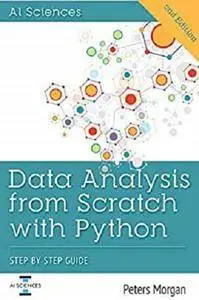Data Analysis from Scratch with Python: Step-by-Step Guide by Peters Morgan
English | August 13, 2018 | ISBN: B07GFQCKNR | 133 pages | EPUB | 1.72 Mb
English | August 13, 2018 | ISBN: B07GFQCKNR | 133 pages | EPUB | 1.72 Mb
Are you thinking of becoming a data analyst using Python?
If you are looking for a complete guide to data analysis using Python language and its library that will help you to become an effective data scientist, this book is for you.
From AI Sciences Publisher
Our books may be the best one for beginners; it's a step-by-step guide for any person who wants to start learning Artificial Intelligence and Data Science from scratch. It will help you in preparing a solid foundation and learn any other high-level courses.
To get the most out of the concepts that would be covered, readers are advised to adopt hands on approach, which would lead to better mental representations.
Step By Step Guide and Visual Illustrations and Examples
The Book give complete instructions for manipulating, processing, cleaning, modeling and crunching datasets in Python. This is a hands-on guide with practical case studies of data analysis problems effectively. You will learn pandas, NumPy, IPython, and Jupiter in the Process.
Target Users
This book is a practical introduction to data science tools in Python. It is ideal for analyst’s beginners to Python and for Python programmers new to data science and computer science. Instead of tough math formulas, this book contains several graphs and images.
What’s Inside This Book?
Why Choose Python for Data Science & Machine Learning
Prerequisites & Reminders
Python Quick Review
Overview & Objectives
A Quick Example
Getting & Processing Data
Data Visualization
Supervised & Unsupervised Learning
Regression
Simple Linear Regression
Multiple Linear Regression
Decision Tree
Random Forest
Classification
Logistic Regression
K-Nearest Neighbors
Decision Tree Classification
Random Forest Classification
Clustering
Goals & Uses of Clustering
K-Means Clustering
Anomaly Detection
Association Rule Learning
Explanation
Apriori
Reinforcement Learning
What is Reinforcement Learning
Comparison with Supervised & Unsupervised Learning
Applying Reinforcement Learning
Neural Networks
An Idea of How the Brain Works
Potential & Constraints
Here’s an Example
Natural Language Processing
Analyzing Words & Sentiments
Using NLTK
Model Selection & Improving Performance
Sources & References
Prerequisites & Reminders
Python Quick Review
Overview & Objectives
A Quick Example
Getting & Processing Data
Data Visualization
Supervised & Unsupervised Learning
Regression
Simple Linear Regression
Multiple Linear Regression
Decision Tree
Random Forest
Classification
Logistic Regression
K-Nearest Neighbors
Decision Tree Classification
Random Forest Classification
Clustering
Goals & Uses of Clustering
K-Means Clustering
Anomaly Detection
Association Rule Learning
Explanation
Apriori
Reinforcement Learning
What is Reinforcement Learning
Comparison with Supervised & Unsupervised Learning
Applying Reinforcement Learning
Neural Networks
An Idea of How the Brain Works
Potential & Constraints
Here’s an Example
Natural Language Processing
Analyzing Words & Sentiments
Using NLTK
Model Selection & Improving Performance
Sources & References



